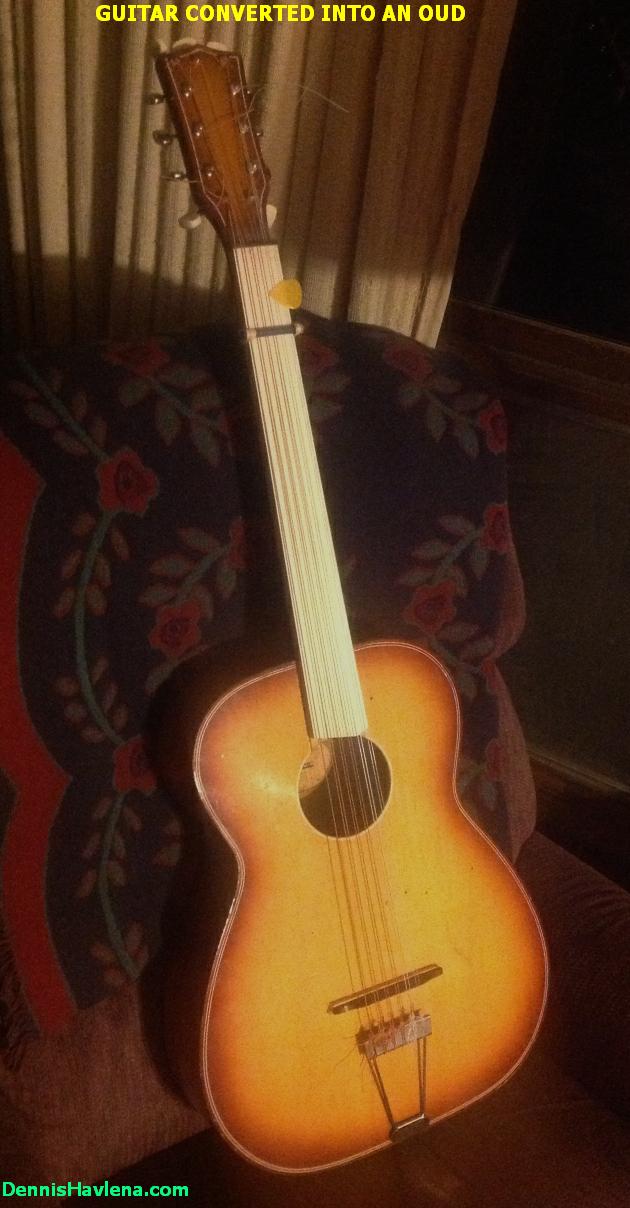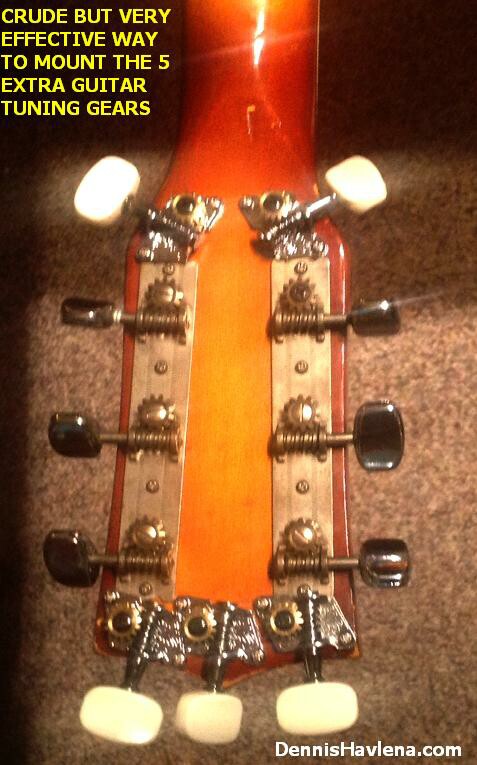
An Oud most often has 11 nylon strings - the bottom ones copper wound on nylon. It has five same-gauge doubled pairs of strings & a single low bass. How can a 6-string guitar survive the string strain/tension of 11 strings you might ask? Well, a minimum of poking around the internet puts the issue to rest: - Typical Oud strings, Aquila Nylgut "# 13o" exert a total of 94.6 lbs. - D'Addario number "# EJ16" medium gauge steel guitar strings exert a total of 163.2 lbs. - Savarez number "# 520B" nylon guitar strings exert a total of 93.6 lbs. So you can see that Oud strings will put no undue strain on either an acoustic steel nor a typically more lightly built classical nylon guitar - AS IS - without having to add any extra bracing etc. 12-strings guitars will obviously work fine as well. Putting nylon strings on a steel-string guitar is generally not advisable but in this case, the doubled notes of the Oud strings tend to make up for the loss of sound/volume.


I plan to make a short sound sample or youtube video but knowing
very little about playing the Oud, this may be a bit down the road.
These few steps must be taken for converting six-string guitars.
1) TUNING GEARS: Five extra guitar tuners have to be added to
the tuning head. This may not sound poissible but with a bit of
planning can fairly easily be done. I can't guarantee that the
results will be pleasing to the eye but so what - it'll work
nicely. Three tuners usually can be fit around the tip --
two will usually fit next to the two guitar's E-strings. If the
plates of the tuners hit each other, hacksaw &/or file off
any non-critical part til everything fits flat.
2) FRETS must be removed from the guitar's fingerboard (Ouds are
fretless). Sometimes it's an easy job if you first heat each
fret thoroughly with a soldering gun to melt any glue.
Stubborn frets can be coaxed out by heating & then gently
hammering (sliding) them along their grooves. However you do it,
take care that you don't rip up a chunk of fingerboard in the
process (easy to do). I've learned by long experience that you
need not fill in the fret holes - just carefully sand flush
any glue or projection. Note: on my current conversion
(pictured) the fretboard was in such bad condition that it was
falling apart - unusable - so I departed from these instructions
and instead made up a simple new fingerboard from a scrap of
formica-covered hardwood (thus the white surface). The formica
makes a fine fretless surface.
3) BRIDGE: Rework the bridge a bit to accommodate double strings.
On guitars where strings are held in with bridge pins: Simply
file a second groove in the bridge saddle 3.5 mm next to each
of the five thinnest strings. The bass string, not being doubled,
needs no attention. The bridge pins will easily take the strain
of a pair of strings being inserted in each pin hole.
Note : Oud strings as purchased do not have balls or anything
on either end -- you'll have to create big knots so the strings
will stay put in their holes. On guitars with a tailpiece: Most
bridges can easily be modified by filing a second groove 3.5 mm
next to each of the five thinnest strings.
4) NUT: Although it sometimes works to simply file extra grooves
in the existing nut to accommodate the five new strings (& then
deepening all notches), more often than not there's not enough
room in which case, a new nut can easily be made - even the wood
from a spring clothespin can make a good nut. Because the Oud is
fretless, make the nut slots a tiny bit deeper than the level of
the fingerboard (angle the nut cut downwards towards the tuner end).
That's about it! This conversion ends up with an Oud whose
fingerboard/stringlength is a couple of inches longer than on a
traditional Oud. I easily solve this problem by using a capo (I prefer
one made with a pencil & rubberbands) placed a few inches up from the nut.
Set it for a 600 mm string-length. Caution: USE THE CAPO because
if you try to tune the instrument up to an Oud's traditional pitch
withOUT the capo, the strings will most likely break. One nice feature
of the capo on a fretless fingerboard is that you can quickly adjust
the instrument's overall pitch to match who or whatever you are
playing with.
If you use a 12-string guitar, no real conversion is needed other
than fret removal, string change & use of the capo.
There are a number of traditional Oud tunings.
The one I see most often (the one I use) is (low to high)
F CC DD GG CC FF
( F C3 D3 G3 C4 F4)
Above-mentioned Aquila Oud Strings (around $15 in 2013) and guitar
tuning machines (I recommend Elderly part # GTM-21 at less than $2
per) are available online at http://elderly.com
As an aside - this instrument can be quickly tuned like a guitar
E A D G B E ( LEAVE THE CAPO ON - because you're using Oud strings now).
There are very few fretless guitar players in this world but after
experimenting with no frets on a guitar years ago and finding it
quite a bit of fun, this configuration doubles nicely as a fretless
guitar. Hint: think melody not chords!
Dennis Havlena - W8MI
northern Michigan
dhavlena@gmail.com
DennisHavlena.com
Click here to access
my webpage
Keywords: oud guitar diy make build convert conversion havlena north african
arabic instrument instruments musical ud